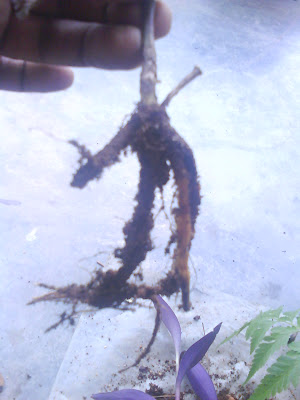
It all started with the idea of making my side corner garden area beautiful. That is something nicer than this heavy looking Heliconia plant with its leaves falling all over.
I started removing the mess and guess what?
More mess.


.
Before scrolling down;
Please Be Warned.
Before A Well Organised Garden takes place, there is always a MESSY GARDEN.
.
Well you know what, there is no such thing as a well organised garden. Garden are garden, no matter how and what one may plan & plant..
.
They will somehow find their wild side and shock you....
(As it was the earlier case with my Heliconia)
And all the mess from one side invaded the other side as you see below....
.
(together with my on the spot replanting which I manage to settle for the Ferns, Purple Queen, Cane Begonia, Roses, Ixora and Night Blooming Jasmine)

Finally, one by one are sorted and settled in my best thought areas: Night blooming Jasmine and Yellow Ixora which I got them from my mum.
I got this Maiden Hair Fern also from my mum (seemed like she is the supplier of most of my plants) She wanted to clear her mess and passed this one to me.
.
I got another few tiles which I stacked up. They need washing as I just notice the dirt now in this picture.
.
(planning to place some nice pots to make a statement kind of effect.. still thinking about it)
.
She passed all the big version of the Maiden Hair Ferns. So I thought of alternating the small and the big in a row, after doing so - they seemed to look nice. I manage to snap a picture just the ferns together with the creeping fig... they really give that cascading look.


Yellow Ixora flower - still blooming when I was doing this sorting, also Night Blooming Jasmine.
(probably will do another write on both of them later)

This is the over-all view of the near finish work area.
.
I may need to rearrange and sort it time to time as time goes, but as for now, this is more like the final work done. Flame violets hanging with Coleus and Begonias at the background.
.
Actually the mix of colours really make the place look nice even though they look strong with clashing colours.



I also managed to rearrange this area. Not much of a difference from the earlier arrangement but its much more better compared to before. I had removed the palm orchid and placed it back where it was originally and sorting this one with a reverse arranged from tall to short.
.
(so far, nothing died from my earlier planting except for ants invasion and mealy bugs farmed by these ants....urrrggghhhh!!!!)
.
As for now, this will have to do until I get some bright ideas.
I still got few more plants waiting for me to plant:
.
Few species of Coleus which I manage to take from my mum, a bunch of Wormwood plant and Black Velvet Begonia which really need some pruning and replanting































































